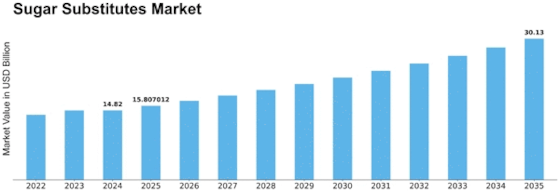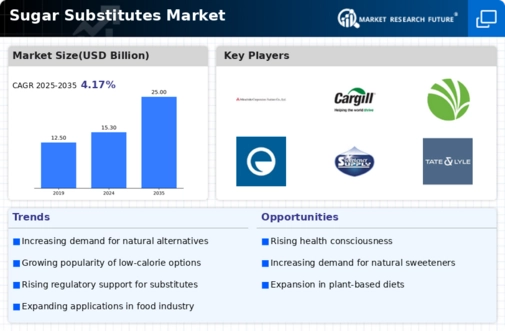Natural Sweeteners
Artificial Sweeteners
Sugar Alcohols
High-Intensity Sweeteners
Powder
Liquid
Granular
Tabletop
Food and Beverages
Pharmaceuticals
Personal Care Products
Nutraceuticals
Household
Food Service
Retail
North America
Europe
South America
Asia Pacific
Middle East and Africa
North America Outlook (USD Billion, 2019-2035)
North America Sugar Substitutes Market by Type
Natural Sweeteners
Artificial Sweeteners
Sugar Alcohols
High-Intensity Sweeteners
North America Sugar Substitutes Market by Form Type
Powder
Liquid
Granular
Tabletop
North America Sugar Substitutes Market by Application Type
Food and Beverages
Pharmaceuticals
Personal Care Products
Nutraceuticals
North America Sugar Substitutes Market by End Use Type
Household
Food Service
Retail
North America Sugar Substitutes Market by Regional Type
US
Canada
US Outlook (USD Billion, 2019-2035)
US Sugar Substitutes Market by Type
Natural Sweeteners
Artificial Sweeteners
Sugar Alcohols
High-Intensity Sweeteners
US Sugar Substitutes Market by Form Type
Powder
Liquid
Granular
Tabletop
US Sugar Substitutes Market by Application Type
Food and Beverages
Pharmaceuticals
Personal Care Products
Nutraceuticals
US Sugar Substitutes Market by End Use Type
Household
Food Service
Retail
CANADA Outlook (USD Billion, 2019-2035)
CANADA Sugar Substitutes Market by Type
Natural Sweeteners
Artificial Sweeteners
Sugar Alcohols
High-Intensity Sweeteners
CANADA Sugar Substitutes Market by Form Type
Powder
Liquid
Granular
Tabletop
CANADA Sugar Substitutes Market by Application Type
Food and Beverages
Pharmaceuticals
Personal Care Products
Nutraceuticals
CANADA Sugar Substitutes Market by End Use Type
Household
Food Service
Retail
Europe Outlook (USD Billion, 2019-2035)
Europe Sugar Substitutes Market by Type
Natural Sweeteners
Artificial Sweeteners
Sugar Alcohols
High-Intensity Sweeteners
Europe Sugar Substitutes Market by Form Type
Powder
Liquid
Granular
Tabletop
Europe Sugar Substitutes Market by Application Type
Food and Beverages
Pharmaceuticals
Personal Care Products
Nutraceuticals
Europe Sugar Substitutes Market by End Use Type
Household
Food Service
Retail
Europe Sugar Substitutes Market by Regional Type
Germany
UK
France
Russia
Italy
Spain
Rest of Europe
GERMANY Outlook (USD Billion, 2019-2035)
GERMANY Sugar Substitutes Market by Type
Natural Sweeteners
Artificial Sweeteners
Sugar Alcohols
High-Intensity Sweeteners
GERMANY Sugar Substitutes Market by Form Type
Powder
Liquid
Granular
Tabletop
GERMANY Sugar Substitutes Market by Application Type
Food and Beverages
Pharmaceuticals
Personal Care Products
Nutraceuticals
GERMANY Sugar Substitutes Market by End Use Type
Household
Food Service
Retail
UK Outlook (USD Billion, 2019-2035)
UK Sugar Substitutes Market by Type
Natural Sweeteners
Artificial Sweeteners
Sugar Alcohols
High-Intensity Sweeteners
UK Sugar Substitutes Market by Form Type
Powder
Liquid
Granular
Tabletop
UK Sugar Substitutes Market by Application Type
Food and Beverages
Pharmaceuticals
Personal Care Products
Nutraceuticals
UK Sugar Substitutes Market by End Use Type
Household
Food Service
Retail
FRANCE Outlook (USD Billion, 2019-2035)
FRANCE Sugar Substitutes Market by Type
Natural Sweeteners
Artificial Sweeteners
Sugar Alcohols
High-Intensity Sweeteners
FRANCE Sugar Substitutes Market by Form Type
Powder
Liquid
Granular
Tabletop
FRANCE Sugar Substitutes Market by Application Type
Food and Beverages
Pharmaceuticals
Personal Care Products
Nutraceuticals
FRANCE Sugar Substitutes Market by End Use Type
Household
Food Service
Retail
RUSSIA Outlook (USD Billion, 2019-2035)
RUSSIA Sugar Substitutes Market by Type
Natural Sweeteners
Artificial Sweeteners
Sugar Alcohols
High-Intensity Sweeteners
RUSSIA Sugar Substitutes Market by Form Type
Powder
Liquid
Granular
Tabletop
RUSSIA Sugar Substitutes Market by Application Type
Food and Beverages
Pharmaceuticals
Personal Care Products
Nutraceuticals
RUSSIA Sugar Substitutes Market by End Use Type
Household
Food Service
Retail
ITALY Outlook (USD Billion, 2019-2035)
ITALY Sugar Substitutes Market by Type
Natural Sweeteners
Artificial Sweeteners
Sugar Alcohols
High-Intensity Sweeteners
ITALY Sugar Substitutes Market by Form Type
Powder
Liquid
Granular
Tabletop
ITALY Sugar Substitutes Market by Application Type
Food and Beverages
Pharmaceuticals
Personal Care Products
Nutraceuticals
ITALY Sugar Substitutes Market by End Use Type
Household
Food Service
Retail
SPAIN Outlook (USD Billion, 2019-2035)
SPAIN Sugar Substitutes Market by Type
Natural Sweeteners
Artificial Sweeteners
Sugar Alcohols
High-Intensity Sweeteners
SPAIN Sugar Substitutes Market by Form Type
Powder
Liquid
Granular
Tabletop
SPAIN Sugar Substitutes Market by Application Type
Food and Beverages
Pharmaceuticals
Personal Care Products
Nutraceuticals
SPAIN Sugar Substitutes Market by End Use Type
Household
Food Service
Retail
REST OF EUROPE Outlook (USD Billion, 2019-2035)
REST OF EUROPE Sugar Substitutes Market by Type
Natural Sweeteners
Artificial Sweeteners
Sugar Alcohols
High-Intensity Sweeteners
REST OF EUROPE Sugar Substitutes Market by Form Type
Powder
Liquid
Granular
Tabletop
REST OF EUROPE Sugar Substitutes Market by Application Type
Food and Beverages
Pharmaceuticals
Personal Care Products
Nutraceuticals
REST OF EUROPE Sugar Substitutes Market by End Use Type
Household
Food Service
Retail
APAC Outlook (USD Billion, 2019-2035)
APAC Sugar Substitutes Market by Type
Natural Sweeteners
Artificial Sweeteners
Sugar Alcohols
High-Intensity Sweeteners
APAC Sugar Substitutes Market by Form Type
Powder
Liquid
Granular
Tabletop
APAC Sugar Substitutes Market by Application Type
Food and Beverages
Pharmaceuticals
Personal Care Products
Nutraceuticals
APAC Sugar Substitutes Market by End Use Type
Household
Food Service
Retail
APAC Sugar Substitutes Market by Regional Type
China
India
Japan
South Korea
Malaysia
Thailand
Indonesia
Rest of APAC
CHINA Outlook (USD Billion, 2019-2035)
CHINA Sugar Substitutes Market by Type
Natural Sweeteners
Artificial Sweeteners
Sugar Alcohols
High-Intensity Sweeteners
CHINA Sugar Substitutes Market by Form Type
Powder
Liquid
Granular
Tabletop
CHINA Sugar Substitutes Market by Application Type
Food and Beverages
Pharmaceuticals
Personal Care Products
Nutraceuticals
CHINA Sugar Substitutes Market by End Use Type
Household
Food Service
Retail
INDIA Outlook (USD Billion, 2019-2035)
INDIA Sugar Substitutes Market by Type
Natural Sweeteners
Artificial Sweeteners
Sugar Alcohols
High-Intensity Sweeteners
INDIA Sugar Substitutes Market by Form Type
Powder
Liquid
Granular
Tabletop
INDIA Sugar Substitutes Market by Application Type
Food and Beverages
Pharmaceuticals
Personal Care Products
Nutraceuticals
INDIA Sugar Substitutes Market by End Use Type
Household
Food Service
Retail
JAPAN Outlook (USD Billion, 2019-2035)
JAPAN Sugar Substitutes Market by Type
Natural Sweeteners
Artificial Sweeteners
Sugar Alcohols
High-Intensity Sweeteners
JAPAN Sugar Substitutes Market by Form Type
Powder
Liquid
Granular
Tabletop
JAPAN Sugar Substitutes Market by Application Type
Food and Beverages
Pharmaceuticals
Personal Care Products
Nutraceuticals
JAPAN Sugar Substitutes Market by End Use Type
Household
Food Service
Retail
SOUTH KOREA Outlook (USD Billion, 2019-2035)
SOUTH KOREA Sugar Substitutes Market by Type
Natural Sweeteners
Artificial Sweeteners
Sugar Alcohols
High-Intensity Sweeteners
SOUTH KOREA Sugar Substitutes Market by Form Type
Powder
Liquid
Granular
Tabletop
SOUTH KOREA Sugar Substitutes Market by Application Type
Food and Beverages
Pharmaceuticals
Personal Care Products
Nutraceuticals
SOUTH KOREA Sugar Substitutes Market by End Use Type
Household
Food Service
Retail
MALAYSIA Outlook (USD Billion, 2019-2035)
MALAYSIA Sugar Substitutes Market by Type
Natural Sweeteners
Artificial Sweeteners
Sugar Alcohols
High-Intensity Sweeteners
MALAYSIA Sugar Substitutes Market by Form Type
Powder
Liquid
Granular
Tabletop
MALAYSIA Sugar Substitutes Market by Application Type
Food and Beverages
Pharmaceuticals
Personal Care Products
Nutraceuticals
MALAYSIA Sugar Substitutes Market by End Use Type
Household
Food Service
Retail
THAILAND Outlook (USD Billion, 2019-2035)
THAILAND Sugar Substitutes Market by Type
Natural Sweeteners
Artificial Sweeteners
Sugar Alcohols
High-Intensity Sweeteners
THAILAND Sugar Substitutes Market by Form Type
Powder
Liquid
Granular
Tabletop
THAILAND Sugar Substitutes Market by Application Type
Food and Beverages
Pharmaceuticals
Personal Care Products
Nutraceuticals
THAILAND Sugar Substitutes Market by End Use Type
Household
Food Service
Retail
INDONESIA Outlook (USD Billion, 2019-2035)
INDONESIA Sugar Substitutes Market by Type
Natural Sweeteners
Artificial Sweeteners
Sugar Alcohols
High-Intensity Sweeteners
INDONESIA Sugar Substitutes Market by Form Type
Powder
Liquid
Granular
Tabletop
INDONESIA Sugar Substitutes Market by Application Type
Food and Beverages
Pharmaceuticals
Personal Care Products
Nutraceuticals
INDONESIA Sugar Substitutes Market by End Use Type
Household
Food Service
Retail
REST OF APAC Outlook (USD Billion, 2019-2035)
REST OF APAC Sugar Substitutes Market by Type
Natural Sweeteners
Artificial Sweeteners
Sugar Alcohols
High-Intensity Sweeteners
REST OF APAC Sugar Substitutes Market by Form Type
Powder
Liquid
Granular
Tabletop
REST OF APAC Sugar Substitutes Market by Application Type
Food and Beverages
Pharmaceuticals
Personal Care Products
Nutraceuticals
REST OF APAC Sugar Substitutes Market by End Use Type
Household
Food Service
Retail
South America Outlook (USD Billion, 2019-2035)
South America Sugar Substitutes Market by Type
Natural Sweeteners
Artificial Sweeteners
Sugar Alcohols
High-Intensity Sweeteners
South America Sugar Substitutes Market by Form Type
Powder
Liquid
Granular
Tabletop
South America Sugar Substitutes Market by Application Type
Food and Beverages
Pharmaceuticals
Personal Care Products
Nutraceuticals
South America Sugar Substitutes Market by End Use Type
Household
Food Service
Retail
South America Sugar Substitutes Market by Regional Type
Brazil
Mexico
Argentina
Rest of South America
BRAZIL Outlook (USD Billion, 2019-2035)
BRAZIL Sugar Substitutes Market by Type
Natural Sweeteners
Artificial Sweeteners
Sugar Alcohols
High-Intensity Sweeteners
BRAZIL Sugar Substitutes Market by Form Type
Powder
Liquid
Granular
Tabletop
BRAZIL Sugar Substitutes Market by Application Type
Food and Beverages
Pharmaceuticals
Personal Care Products
Nutraceuticals
BRAZIL Sugar Substitutes Market by End Use Type
Household
Food Service
Retail
MEXICO Outlook (USD Billion, 2019-2035)
MEXICO Sugar Substitutes Market by Type
Natural Sweeteners
Artificial Sweeteners
Sugar Alcohols
High-Intensity Sweeteners
MEXICO Sugar Substitutes Market by Form Type
Powder
Liquid
Granular
Tabletop
MEXICO Sugar Substitutes Market by Application Type
Food and Beverages
Pharmaceuticals
Personal Care Products
Nutraceuticals
MEXICO Sugar Substitutes Market by End Use Type
Household
Food Service
Retail
ARGENTINA Outlook (USD Billion, 2019-2035)
ARGENTINA Sugar Substitutes Market by Type
Natural Sweeteners
Artificial Sweeteners
Sugar Alcohols
High-Intensity Sweeteners
ARGENTINA Sugar Substitutes Market by Form Type
Powder
Liquid
Granular
Tabletop
ARGENTINA Sugar Substitutes Market by Application Type
Food and Beverages
Pharmaceuticals
Personal Care Products
Nutraceuticals
ARGENTINA Sugar Substitutes Market by End Use Type
Household
Food Service
Retail
REST OF SOUTH AMERICA Outlook (USD Billion, 2019-2035)
REST OF SOUTH AMERICA Sugar Substitutes Market by Type
Natural Sweeteners
Artificial Sweeteners
Sugar Alcohols
High-Intensity Sweeteners
REST OF SOUTH AMERICA Sugar Substitutes Market by Form Type
Powder
Liquid
Granular
Tabletop
REST OF SOUTH AMERICA Sugar Substitutes Market by Application Type
Food and Beverages
Pharmaceuticals
Personal Care Products
Nutraceuticals
REST OF SOUTH AMERICA Sugar Substitutes Market by End Use Type
Household
Food Service
Retail
MEA Outlook (USD Billion, 2019-2035)
MEA Sugar Substitutes Market by Type
Natural Sweeteners
Artificial Sweeteners
Sugar Alcohols
High-Intensity Sweeteners
MEA Sugar Substitutes Market by Form Type
Powder
Liquid
Granular
Tabletop
MEA Sugar Substitutes Market by Application Type
Food and Beverages
Pharmaceuticals
Personal Care Products
Nutraceuticals
MEA Sugar Substitutes Market by End Use Type
Household
Food Service
Retail
MEA Sugar Substitutes Market by Regional Type
GCC Countries
South Africa
Rest of MEA
GCC COUNTRIES Outlook (USD Billion, 2019-2035)
GCC COUNTRIES Sugar Substitutes Market by Type
Natural Sweeteners
Artificial Sweeteners
Sugar Alcohols
High-Intensity Sweeteners
GCC COUNTRIES Sugar Substitutes Market by Form Type
Powder
Liquid
Granular
Tabletop
GCC COUNTRIES Sugar Substitutes Market by Application Type
Food and Beverages
Pharmaceuticals
Personal Care Products
Nutraceuticals
GCC COUNTRIES Sugar Substitutes Market by End Use Type
Household
Food Service
Retail
SOUTH AFRICA Outlook (USD Billion, 2019-2035)
SOUTH AFRICA Sugar Substitutes Market by Type
Natural Sweeteners
Artificial Sweeteners
Sugar Alcohols
High-Intensity Sweeteners
SOUTH AFRICA Sugar Substitutes Market by Form Type
Powder
Liquid
Granular
Tabletop
SOUTH AFRICA Sugar Substitutes Market by Application Type
Food and Beverages
Pharmaceuticals
Personal Care Products
Nutraceuticals
SOUTH AFRICA Sugar Substitutes Market by End Use Type
Household
Food Service
Retail
REST OF MEA Outlook (USD Billion, 2019-2035)
REST OF MEA Sugar Substitutes Market by Type
Natural Sweeteners
Artificial Sweeteners
Sugar Alcohols
High-Intensity Sweeteners
REST OF MEA Sugar Substitutes Market by Form Type
Powder
Liquid
Granular
Tabletop
REST OF MEA Sugar Substitutes Market by Application Type
Food and Beverages
Pharmaceuticals
Personal Care Products
Nutraceuticals
REST OF MEA Sugar Substitutes Market by End Use Type
Household
Food Service
Retail


















Leave a Comment